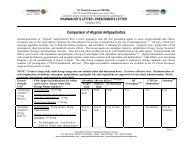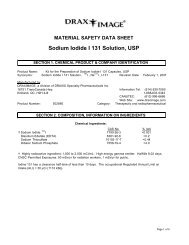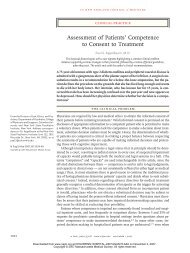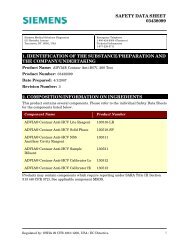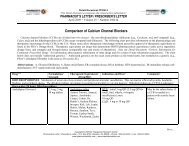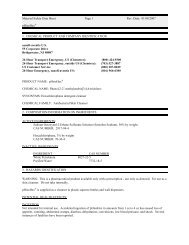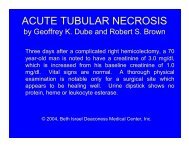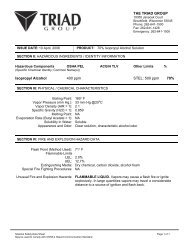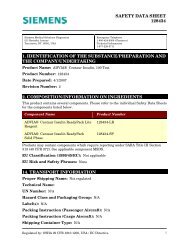Disclosing Harmful Medical Errors to Patients - Harvard University
Disclosing Harmful Medical Errors to Patients - Harvard University
Disclosing Harmful Medical Errors to Patients - Harvard University
You also want an ePaper? Increase the reach of your titles
YUMPU automatically turns print PDFs into web optimized ePapers that Google loves.
T h e n e w e ng l a nd j o u r na l o f m e dic i n ethe expression of regret, not accompanying informationrelated <strong>to</strong> causality (“our care causedyour injury”) or fault (“this should not have happened”).In addition, plaintiffs’ at<strong>to</strong>rneys, whomust sift through dozens of prospective claimsin choosing which ones <strong>to</strong> pursue, will prize informationgained from disclosures, whether ornot they are permitted <strong>to</strong> use that information asevidence in subsequent litigation. Thus, althoughapology laws are useful policy endorsements ofdisclosure, they will probably have little influenceon disclosure behavior.The potential for <strong>to</strong>p-down regulation <strong>to</strong> havea meaningful effect on disclosure conversationsis limited. The most successful disclosure initiativesare likely <strong>to</strong> be those that emerge locally, aredriven by an institutional leadership and a workforcecommitted <strong>to</strong> transparency, and focus onproviding health care workers with the skills needed<strong>to</strong> conduct these difficult conversations well.There is considerable speculation and debateabout the impact of disclosure on litigation.Patient-safety experts and proponents of disclosure<strong>to</strong>ut its litigation-reducing potential andpoint <strong>to</strong> several success s<strong>to</strong>ries (which we reviewbelow) as well as research linking poor communicationwith patients’ decisions <strong>to</strong> sue. 37-39 The actualeffect is not known and will not be evidentfor years. Overall, disclosure probably will nothave the chilling effect on litigation that someadvocates have claimed. Although disclosure mayquell some patients’ interest in litigating, it willignite interest in others, particularly those whowould never have known of their injury in the absenceof the disclosure. The net impact of disclosureon the size and cost of litigation ultimatelydepends on the balance between these twoeffects. 40Prominen t Discl osur e Pro gr a msAlthough many organizations are experimentingwith disclosure initiatives, relatively little is knownabout their effectiveness. In 1999, the VeteransAffairs Hospital in Lexing<strong>to</strong>n, Kentucky, issuedthe first published report of the effect of an opendisclosureprogram. There were no dramaticchanges in the volume of claims or the size ofpayouts after the hospital adopted the program. 14Recently, the <strong>University</strong> of Michigan Health Systemreported that the cost and frequency of litigationdecreased substantially in the 5 years afterthe implementation of an open-disclosure program,with annual litigation expenses reducedfrom $3 million <strong>to</strong> $1 million and the number ofclaims decreasing by more than 50%. 15 These twoinitiatives clearly spotlight institutions with a seriouscommitment <strong>to</strong> transparency. The data areprovocative but difficult <strong>to</strong> interpret because theyrely largely on his<strong>to</strong>rical comparison groups anddo not attempt <strong>to</strong> control for other fac<strong>to</strong>rs thatinfluence litigation rates and outcomes over time.In addition, the generalizability of the results ata single Veterans Affairs hospital and a singleacademic institution is questionable.The best-known private-sec<strong>to</strong>r disclosure programis the “3Rs” program at COPIC, a liabilityinsurer directed by physicians in Colorado. COPICinsures approximately 6000 physicians and is thelargest insurer in Colorado. In 2000, the companydeveloped a program designed <strong>to</strong> facilitatetransparent communication about injuries and expeditecompensation in selected circumstances. 41The program’s key features and outcomes arelisted in Table 2.The 3Rs program links interventions <strong>to</strong> improvecommunication with a mechanism that providespatients with up <strong>to</strong> $30,000 in compensationfor out-of-pocket health care expenses and“loss of time.” The program is “no-fault” in thatit does not tie compensation <strong>to</strong> evidence of faul<strong>to</strong>n the provider’s part. The payments are notmade in response <strong>to</strong> written demands, and patientsdo not waive their rights <strong>to</strong> sue, so 3Rspayments are not considered reportable <strong>to</strong> theNational Practitioner Data Bank.The 3Rs program has handled more than 3000events; approximately one quarter of the patientsinvolved received payments averaging $5,400 each.Seven cases in which patients were paid proceeded<strong>to</strong> litigation. Two cases resulted in additional<strong>to</strong>rt payments. Sixteen 3Rs cases that closedwithout payments were subsequently litigated; sixof the patients secured <strong>to</strong>rt compensation (LembitzA: personal communication). Although therange of cases handled by the COPIC program islimited, the outcomes suggest that these eventscan be resolved less adversarially than they mightbe by means of traditional litigation. In addition,the low average payment per incident reinforcesthe view that maximum compensation is frequentlynot the main objective for patients in the wakeof medical injury. 42Whether COPIC’s outcomes can be general2716n engl j med 356;26 www.nejm.org june 28, 2007Downloaded from www.nejm.org at HARVARD UNIVERSITY on June 29, 2007 .Copyright © 2007 Massachusetts <strong>Medical</strong> Society. All rights reserved.



